Organisational Behaviour Report: TESCO - Individual and Team Dynamics
VerifiedAdded on 2021/02/21
|16
|5069
|29
Report
AI Summary
This report provides a comprehensive analysis of organisational behaviour, using TESCO, a British retail company, as a case study. The report explores how organisational culture, power dynamics, and workplace politics influence individual and team behaviour and performance. It delves into the application of power structures (coercive and reward) and Handy's Culture model within TESCO. The report also examines content (Maslow's hierarchy) and process theories of motivation, alongside discussions on effective and ineffective teams. Furthermore, it applies organisational behaviour concepts and philosophies to a business situation, offering insights into TESCO's approach to employee management, motivation, and team dynamics, considering Hofstede’s cultural dimensions. The report highlights the importance of motivation, both extrinsic and intrinsic, and examines how TESCO implements strategies to enhance employee performance through rewards, training, and a focus on creating a positive work environment.
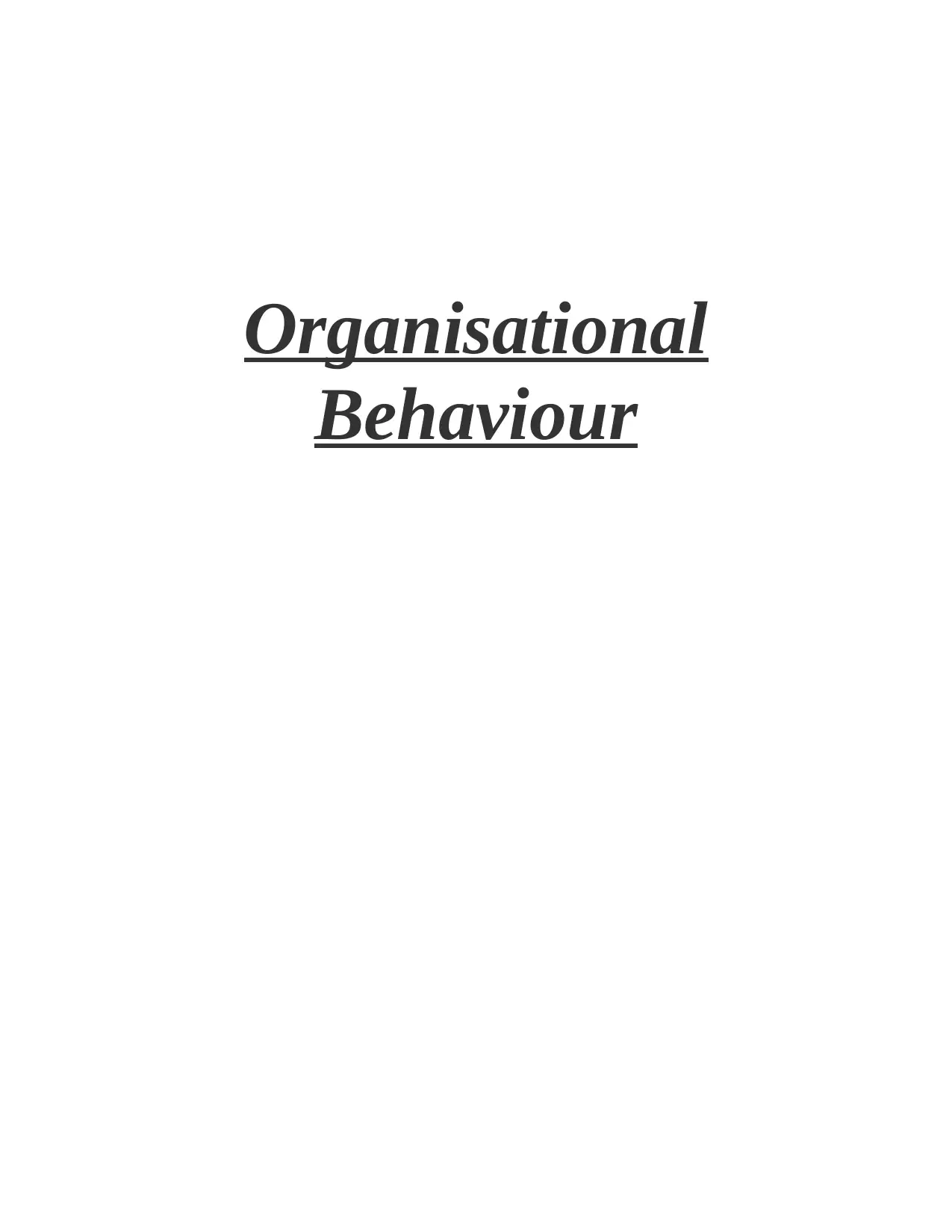
Organisational
Behaviour
Behaviour
Paraphrase This Document
Need a fresh take? Get an instant paraphrase of this document with our AI Paraphraser
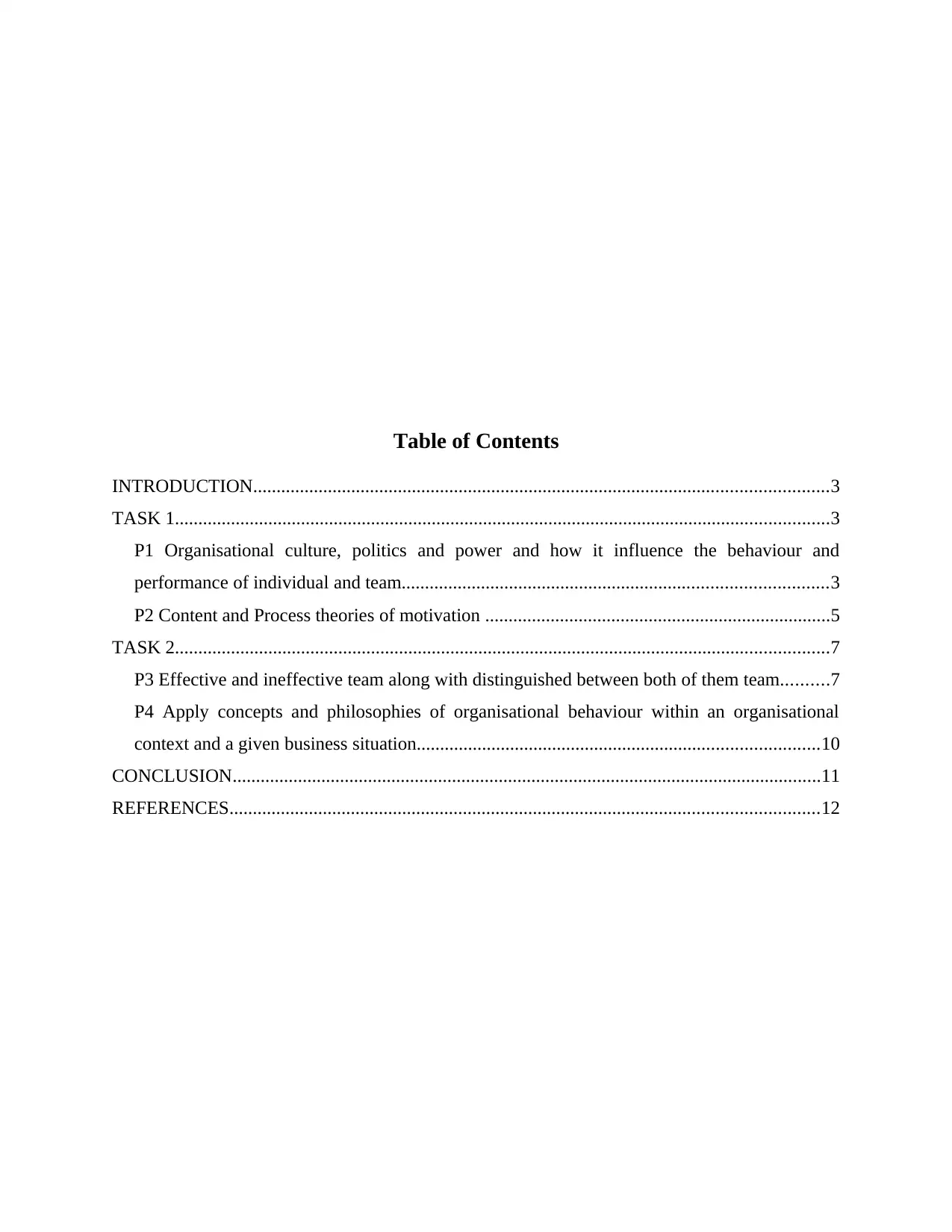
Table of Contents
INTRODUCTION...........................................................................................................................3
TASK 1............................................................................................................................................3
P1 Organisational culture, politics and power and how it influence the behaviour and
performance of individual and team...........................................................................................3
P2 Content and Process theories of motivation ..........................................................................5
TASK 2............................................................................................................................................7
P3 Effective and ineffective team along with distinguished between both of them team..........7
P4 Apply concepts and philosophies of organisational behaviour within an organisational
context and a given business situation......................................................................................10
CONCLUSION..............................................................................................................................11
REFERENCES..............................................................................................................................12
INTRODUCTION...........................................................................................................................3
TASK 1............................................................................................................................................3
P1 Organisational culture, politics and power and how it influence the behaviour and
performance of individual and team...........................................................................................3
P2 Content and Process theories of motivation ..........................................................................5
TASK 2............................................................................................................................................7
P3 Effective and ineffective team along with distinguished between both of them team..........7
P4 Apply concepts and philosophies of organisational behaviour within an organisational
context and a given business situation......................................................................................10
CONCLUSION..............................................................................................................................11
REFERENCES..............................................................................................................................12
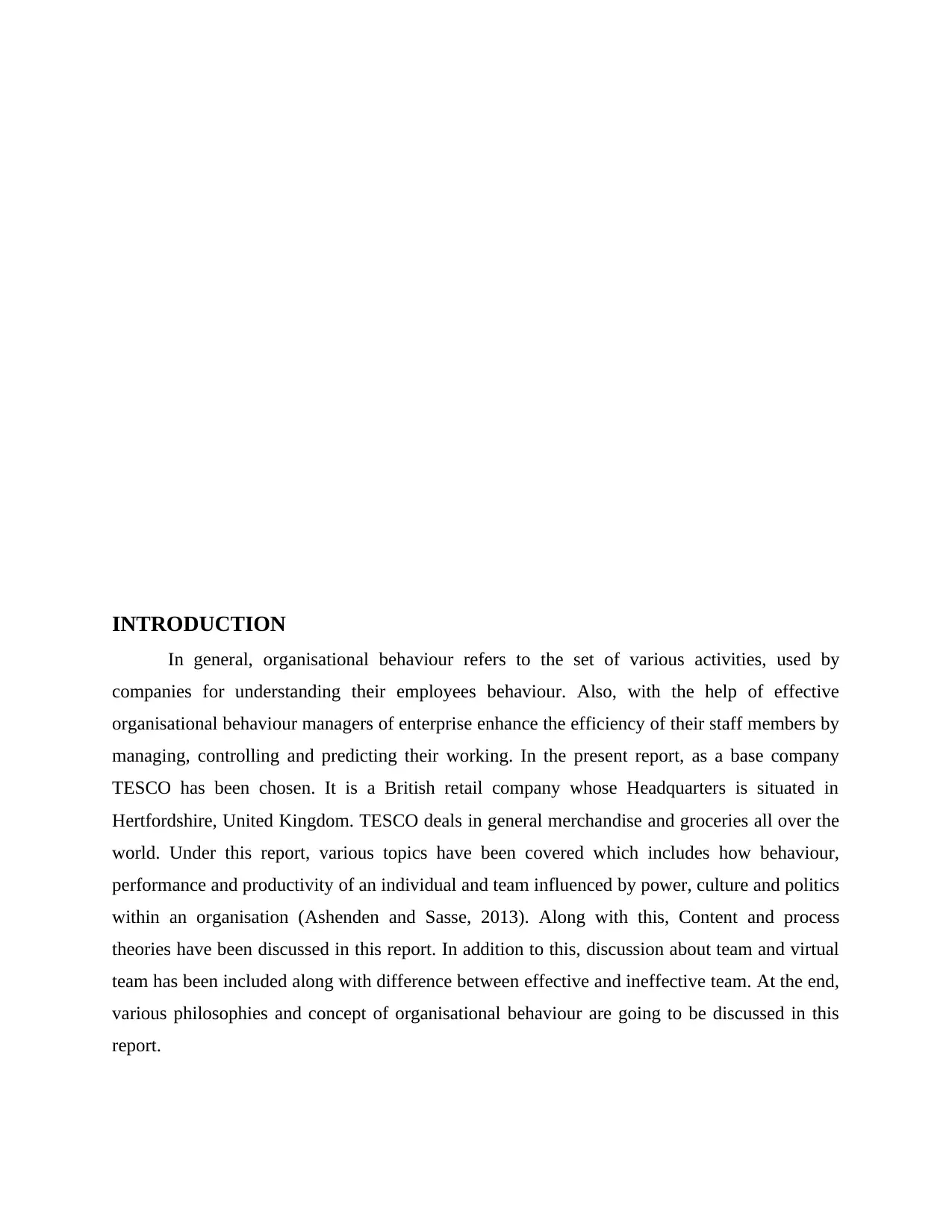
INTRODUCTION
In general, organisational behaviour refers to the set of various activities, used by
companies for understanding their employees behaviour. Also, with the help of effective
organisational behaviour managers of enterprise enhance the efficiency of their staff members by
managing, controlling and predicting their working. In the present report, as a base company
TESCO has been chosen. It is a British retail company whose Headquarters is situated in
Hertfordshire, United Kingdom. TESCO deals in general merchandise and groceries all over the
world. Under this report, various topics have been covered which includes how behaviour,
performance and productivity of an individual and team influenced by power, culture and politics
within an organisation (Ashenden and Sasse, 2013). Along with this, Content and process
theories have been discussed in this report. In addition to this, discussion about team and virtual
team has been included along with difference between effective and ineffective team. At the end,
various philosophies and concept of organisational behaviour are going to be discussed in this
report.
In general, organisational behaviour refers to the set of various activities, used by
companies for understanding their employees behaviour. Also, with the help of effective
organisational behaviour managers of enterprise enhance the efficiency of their staff members by
managing, controlling and predicting their working. In the present report, as a base company
TESCO has been chosen. It is a British retail company whose Headquarters is situated in
Hertfordshire, United Kingdom. TESCO deals in general merchandise and groceries all over the
world. Under this report, various topics have been covered which includes how behaviour,
performance and productivity of an individual and team influenced by power, culture and politics
within an organisation (Ashenden and Sasse, 2013). Along with this, Content and process
theories have been discussed in this report. In addition to this, discussion about team and virtual
team has been included along with difference between effective and ineffective team. At the end,
various philosophies and concept of organisational behaviour are going to be discussed in this
report.
⊘ This is a preview!⊘
Do you want full access?
Subscribe today to unlock all pages.

Trusted by 1+ million students worldwide
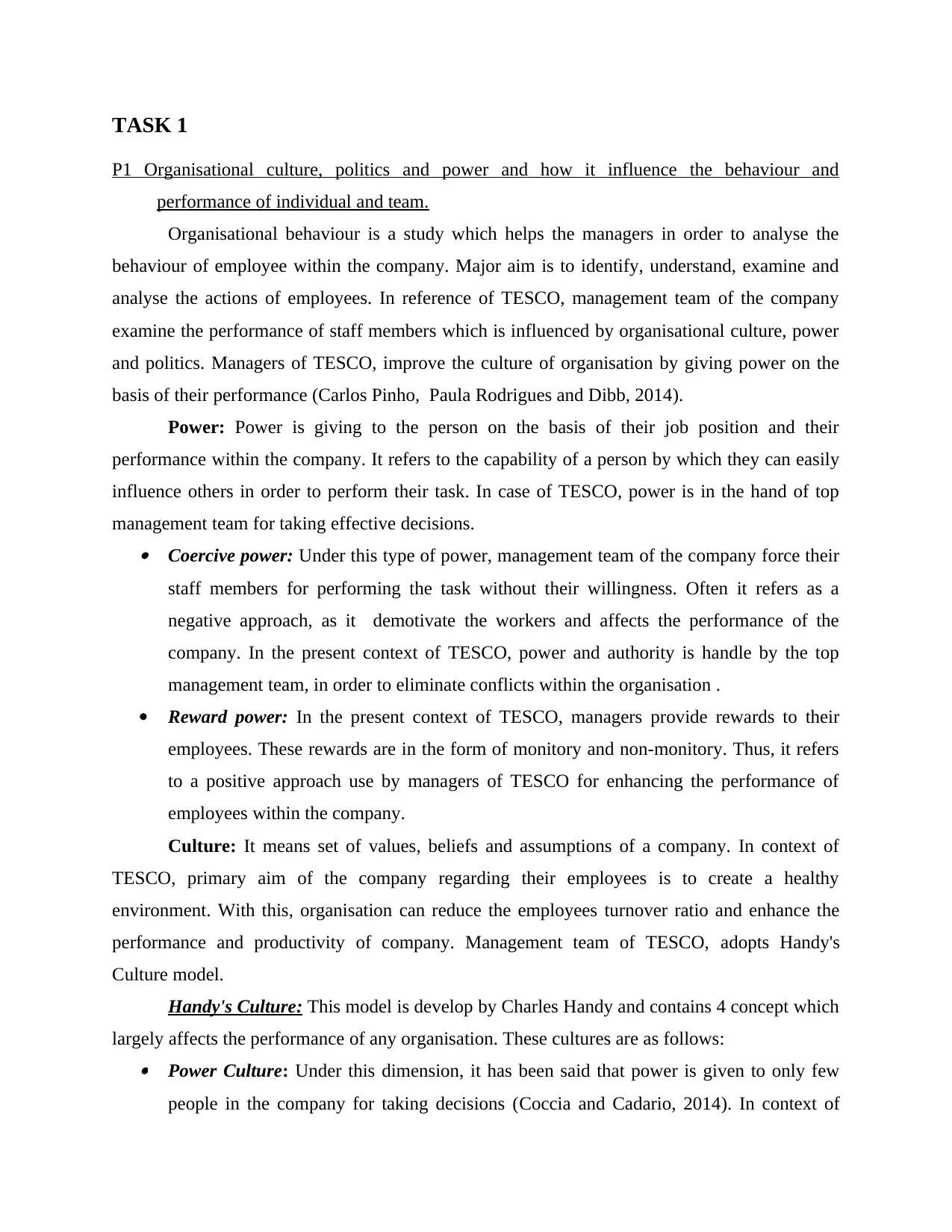
TASK 1
P1 Organisational culture, politics and power and how it influence the behaviour and
performance of individual and team.
Organisational behaviour is a study which helps the managers in order to analyse the
behaviour of employee within the company. Major aim is to identify, understand, examine and
analyse the actions of employees. In reference of TESCO, management team of the company
examine the performance of staff members which is influenced by organisational culture, power
and politics. Managers of TESCO, improve the culture of organisation by giving power on the
basis of their performance (Carlos Pinho, Paula Rodrigues and Dibb, 2014).
Power: Power is giving to the person on the basis of their job position and their
performance within the company. It refers to the capability of a person by which they can easily
influence others in order to perform their task. In case of TESCO, power is in the hand of top
management team for taking effective decisions. Coercive power: Under this type of power, management team of the company force their
staff members for performing the task without their willingness. Often it refers as a
negative approach, as it demotivate the workers and affects the performance of the
company. In the present context of TESCO, power and authority is handle by the top
management team, in order to eliminate conflicts within the organisation .
Reward power: In the present context of TESCO, managers provide rewards to their
employees. These rewards are in the form of monitory and non-monitory. Thus, it refers
to a positive approach use by managers of TESCO for enhancing the performance of
employees within the company.
Culture: It means set of values, beliefs and assumptions of a company. In context of
TESCO, primary aim of the company regarding their employees is to create a healthy
environment. With this, organisation can reduce the employees turnover ratio and enhance the
performance and productivity of company. Management team of TESCO, adopts Handy's
Culture model.
Handy's Culture: This model is develop by Charles Handy and contains 4 concept which
largely affects the performance of any organisation. These cultures are as follows: Power Culture: Under this dimension, it has been said that power is given to only few
people in the company for taking decisions (Coccia and Cadario, 2014). In context of
P1 Organisational culture, politics and power and how it influence the behaviour and
performance of individual and team.
Organisational behaviour is a study which helps the managers in order to analyse the
behaviour of employee within the company. Major aim is to identify, understand, examine and
analyse the actions of employees. In reference of TESCO, management team of the company
examine the performance of staff members which is influenced by organisational culture, power
and politics. Managers of TESCO, improve the culture of organisation by giving power on the
basis of their performance (Carlos Pinho, Paula Rodrigues and Dibb, 2014).
Power: Power is giving to the person on the basis of their job position and their
performance within the company. It refers to the capability of a person by which they can easily
influence others in order to perform their task. In case of TESCO, power is in the hand of top
management team for taking effective decisions. Coercive power: Under this type of power, management team of the company force their
staff members for performing the task without their willingness. Often it refers as a
negative approach, as it demotivate the workers and affects the performance of the
company. In the present context of TESCO, power and authority is handle by the top
management team, in order to eliminate conflicts within the organisation .
Reward power: In the present context of TESCO, managers provide rewards to their
employees. These rewards are in the form of monitory and non-monitory. Thus, it refers
to a positive approach use by managers of TESCO for enhancing the performance of
employees within the company.
Culture: It means set of values, beliefs and assumptions of a company. In context of
TESCO, primary aim of the company regarding their employees is to create a healthy
environment. With this, organisation can reduce the employees turnover ratio and enhance the
performance and productivity of company. Management team of TESCO, adopts Handy's
Culture model.
Handy's Culture: This model is develop by Charles Handy and contains 4 concept which
largely affects the performance of any organisation. These cultures are as follows: Power Culture: Under this dimension, it has been said that power is given to only few
people in the company for taking decisions (Coccia and Cadario, 2014). In context of
Paraphrase This Document
Need a fresh take? Get an instant paraphrase of this document with our AI Paraphraser

TESCO, managers of the company judge their employees on the basis of their
performance and then give them power to take decisions. It is the kind of culture which
discourage the employees and as a result, reduce the productivity of TESCO. Role culture: According to the role culture, management team of TESCO decides some
rules and regulations and them the employees need to perform accordingly. As a result,
every employee within the company is very well aware about their roles and duties. Person Culture: In case of person culture, each and every employee thinks they are the
superior in the company. In context of TESCO, every employee have their own roles
within the company. As a result, each person have some power which makes it difficult
to agree on a same point. .
Task culture: Under the task culture, every person contribute to accomplish the task in an
effective manner. In context of TESCO, managers allot duties to employees according to
their skills and capabilities.
Politics: It means an interaction between employees within the company. Sometimes
politics includes authority and power, which affects the performance of TESCO in a negative
manner. In addition to this, it has been analysed that politics influence the working environment
of company in a negative manner. Some of the factors are as follows: Decline in productivity: In the present context of TESCO, politics reduces the
productivity of company as well as performance of employees. Along with this, staff
members feels distraction due to disputes and conflicts arise within the company.
Enhances the stress level: Within the company, employees feel dissatisfaction due to
politics. As a result it creates stress level within TESCO and reduce the productivity of
employees. Along with this, it has also been examined that politics negatively influence
the performance of company (Coccia, 2014).
As per the above analysis, it has been identified that culture, power, politics higly
influence the performance of employees as well as productivity of company. Along with this,
management team of TESCO, adopts power culture within their organisation, as higher
authorities take full responsibility in order to take decisions. Also, manager of TESCO, provide
rewards to their staff members on the basis of their performance.
performance and then give them power to take decisions. It is the kind of culture which
discourage the employees and as a result, reduce the productivity of TESCO. Role culture: According to the role culture, management team of TESCO decides some
rules and regulations and them the employees need to perform accordingly. As a result,
every employee within the company is very well aware about their roles and duties. Person Culture: In case of person culture, each and every employee thinks they are the
superior in the company. In context of TESCO, every employee have their own roles
within the company. As a result, each person have some power which makes it difficult
to agree on a same point. .
Task culture: Under the task culture, every person contribute to accomplish the task in an
effective manner. In context of TESCO, managers allot duties to employees according to
their skills and capabilities.
Politics: It means an interaction between employees within the company. Sometimes
politics includes authority and power, which affects the performance of TESCO in a negative
manner. In addition to this, it has been analysed that politics influence the working environment
of company in a negative manner. Some of the factors are as follows: Decline in productivity: In the present context of TESCO, politics reduces the
productivity of company as well as performance of employees. Along with this, staff
members feels distraction due to disputes and conflicts arise within the company.
Enhances the stress level: Within the company, employees feel dissatisfaction due to
politics. As a result it creates stress level within TESCO and reduce the productivity of
employees. Along with this, it has also been examined that politics negatively influence
the performance of company (Coccia, 2014).
As per the above analysis, it has been identified that culture, power, politics higly
influence the performance of employees as well as productivity of company. Along with this,
management team of TESCO, adopts power culture within their organisation, as higher
authorities take full responsibility in order to take decisions. Also, manager of TESCO, provide
rewards to their staff members on the basis of their performance.

Hofstede’s 6 cultural dimension- This theory was developed by Geert Hofstede in the year 1980
by Dutch management which is used to understand the difference of various culture and to find
out ways that how to conduct business across different cultures of country. Therefore it is used to
differentiate between different national culture, impact on organisation and dimensions of
culture.
1. Power Distance Index (high versus low)- There is low power distance index at Tesco as
culture encourages organisational structure that are flat, participative style of
management, decentralized decision-making and also focuses on power distribution.
2. Individualism Versus Collectivism- In context of Tesco, great importance is given on the
goals and well-being of group. The self image of individual are defined as “We”.
3. Masculinity Versus Femininity- The managers of Tesco follows Femininity as it has fluid
gender roles, concerned with quality of life, fluid gender roles and managers are modest
with their employee's.
4. Uncertainty Avoidance Index (high versus low)- The company Tesco has high tolerance
for ambiguity, risk taking, uncertainty. The unknown things are more openly accepted
and includes various rules and regulations.
5. Long- Versus Short-Term Orientation- Tesco focus on both short term and long term
goals. In order to achieve long term success short term success is delayed when company
is long term oriented.
6. Indulgence Versus Restraint- The managers of Tesco indicates that society allows
relatively free gratification which is concerned with enjoying life and having lots of fun.
P2 Content and Process theories of motivation
Motivation: It is one of the most important element to encourage the employees of the
company in order to enhance their performance. With the help of positive motivation, managers
of the company enhance the performance of employees but on the other hand negative
motivation reduces the productivity (Coccia, 2014).
For instance, management team of TESCO, use various methods in order to enhance the
performance of employees by motiving them in a positive manner. Rewards, promotions, perks,
incentives, good working condition are given to the employees in order to motivate them to
enhance their performance. There are two types of motivations which are as follows:
by Dutch management which is used to understand the difference of various culture and to find
out ways that how to conduct business across different cultures of country. Therefore it is used to
differentiate between different national culture, impact on organisation and dimensions of
culture.
1. Power Distance Index (high versus low)- There is low power distance index at Tesco as
culture encourages organisational structure that are flat, participative style of
management, decentralized decision-making and also focuses on power distribution.
2. Individualism Versus Collectivism- In context of Tesco, great importance is given on the
goals and well-being of group. The self image of individual are defined as “We”.
3. Masculinity Versus Femininity- The managers of Tesco follows Femininity as it has fluid
gender roles, concerned with quality of life, fluid gender roles and managers are modest
with their employee's.
4. Uncertainty Avoidance Index (high versus low)- The company Tesco has high tolerance
for ambiguity, risk taking, uncertainty. The unknown things are more openly accepted
and includes various rules and regulations.
5. Long- Versus Short-Term Orientation- Tesco focus on both short term and long term
goals. In order to achieve long term success short term success is delayed when company
is long term oriented.
6. Indulgence Versus Restraint- The managers of Tesco indicates that society allows
relatively free gratification which is concerned with enjoying life and having lots of fun.
P2 Content and Process theories of motivation
Motivation: It is one of the most important element to encourage the employees of the
company in order to enhance their performance. With the help of positive motivation, managers
of the company enhance the performance of employees but on the other hand negative
motivation reduces the productivity (Coccia, 2014).
For instance, management team of TESCO, use various methods in order to enhance the
performance of employees by motiving them in a positive manner. Rewards, promotions, perks,
incentives, good working condition are given to the employees in order to motivate them to
enhance their performance. There are two types of motivations which are as follows:
⊘ This is a preview!⊘
Do you want full access?
Subscribe today to unlock all pages.

Trusted by 1+ million students worldwide
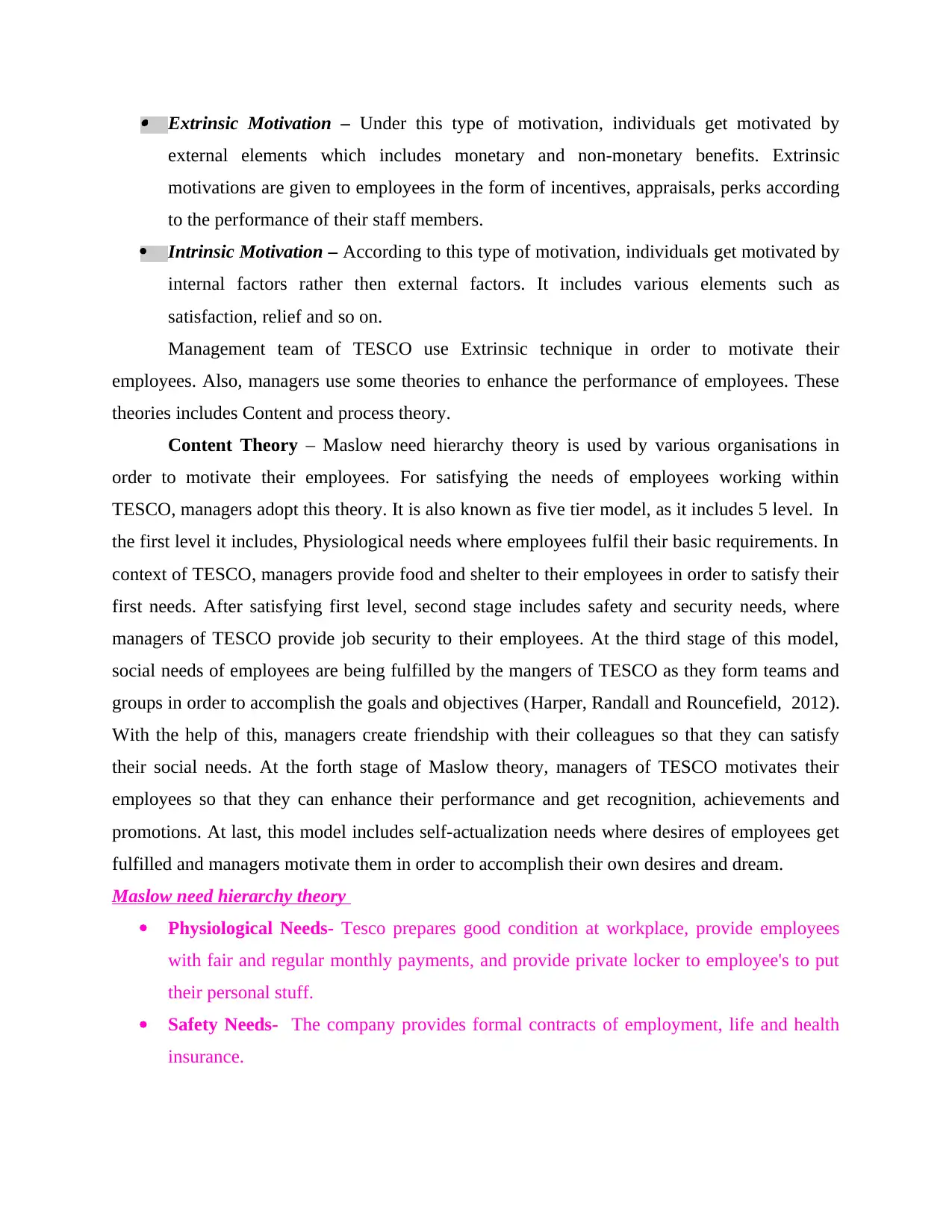
Extrinsic Motivation – Under this type of motivation, individuals get motivated by
external elements which includes monetary and non-monetary benefits. Extrinsic
motivations are given to employees in the form of incentives, appraisals, perks according
to the performance of their staff members.
Intrinsic Motivation – According to this type of motivation, individuals get motivated by
internal factors rather then external factors. It includes various elements such as
satisfaction, relief and so on.
Management team of TESCO use Extrinsic technique in order to motivate their
employees. Also, managers use some theories to enhance the performance of employees. These
theories includes Content and process theory.
Content Theory – Maslow need hierarchy theory is used by various organisations in
order to motivate their employees. For satisfying the needs of employees working within
TESCO, managers adopt this theory. It is also known as five tier model, as it includes 5 level. In
the first level it includes, Physiological needs where employees fulfil their basic requirements. In
context of TESCO, managers provide food and shelter to their employees in order to satisfy their
first needs. After satisfying first level, second stage includes safety and security needs, where
managers of TESCO provide job security to their employees. At the third stage of this model,
social needs of employees are being fulfilled by the mangers of TESCO as they form teams and
groups in order to accomplish the goals and objectives (Harper, Randall and Rouncefield, 2012).
With the help of this, managers create friendship with their colleagues so that they can satisfy
their social needs. At the forth stage of Maslow theory, managers of TESCO motivates their
employees so that they can enhance their performance and get recognition, achievements and
promotions. At last, this model includes self-actualization needs where desires of employees get
fulfilled and managers motivate them in order to accomplish their own desires and dream.
Maslow need hierarchy theory
Physiological Needs- Tesco prepares good condition at workplace, provide employees
with fair and regular monthly payments, and provide private locker to employee's to put
their personal stuff.
Safety Needs- The company provides formal contracts of employment, life and health
insurance.
external elements which includes monetary and non-monetary benefits. Extrinsic
motivations are given to employees in the form of incentives, appraisals, perks according
to the performance of their staff members.
Intrinsic Motivation – According to this type of motivation, individuals get motivated by
internal factors rather then external factors. It includes various elements such as
satisfaction, relief and so on.
Management team of TESCO use Extrinsic technique in order to motivate their
employees. Also, managers use some theories to enhance the performance of employees. These
theories includes Content and process theory.
Content Theory – Maslow need hierarchy theory is used by various organisations in
order to motivate their employees. For satisfying the needs of employees working within
TESCO, managers adopt this theory. It is also known as five tier model, as it includes 5 level. In
the first level it includes, Physiological needs where employees fulfil their basic requirements. In
context of TESCO, managers provide food and shelter to their employees in order to satisfy their
first needs. After satisfying first level, second stage includes safety and security needs, where
managers of TESCO provide job security to their employees. At the third stage of this model,
social needs of employees are being fulfilled by the mangers of TESCO as they form teams and
groups in order to accomplish the goals and objectives (Harper, Randall and Rouncefield, 2012).
With the help of this, managers create friendship with their colleagues so that they can satisfy
their social needs. At the forth stage of Maslow theory, managers of TESCO motivates their
employees so that they can enhance their performance and get recognition, achievements and
promotions. At last, this model includes self-actualization needs where desires of employees get
fulfilled and managers motivate them in order to accomplish their own desires and dream.
Maslow need hierarchy theory
Physiological Needs- Tesco prepares good condition at workplace, provide employees
with fair and regular monthly payments, and provide private locker to employee's to put
their personal stuff.
Safety Needs- The company provides formal contracts of employment, life and health
insurance.
Paraphrase This Document
Need a fresh take? Get an instant paraphrase of this document with our AI Paraphraser

Love And Belongingness Needs- Tesco enabled the team and group working in
organisation and provide employees special discounts and special offers.
Esteem needs- Tesco praise hard and smart workers and celebrate achievement and
emphasis self-respect and respect for others.
Self-Actualization Needs- Tesco develops personal development plan that gives
employee's opportunity to reach higher levels.
Process Theory –It is the theory which is related with individuals psychology. In order
to motivate the employees of TESCO, management team adopt this theory within their
organisation. Under this theory there are 3 stages which includes expectancy, instrumentality and
valence. Expectancy factor is fulfilled by providing right kind of resources to the employees. In
context of TESCO, managers of the company provide training sessions to their employees, so
that they can enhance the productivity and performance of their staff members. On the other
hand, in order to satisfy the instrumentality factor, mangers of TESCO provide benefits, perks
and incentives to their employees according to their performance (Kazemipour and Mohd Amin,
2012). At last, in case of valence factor, employees of the company expect appraisals and for this
managers of TESCO need to analyse the performance of its staff members on a regular basis.
As per the above analysis, it has been examined that, managers of TESCO provide
benefits, incentives, promotions to their employees on the basis of their performance, in order to
motivate them.
TASK 2
P3 Effective and ineffective team along with distinguished between both of them team.
A team is defined, as a mixture of two or more individual with respect to the individual
skills, talents, use of other resource and ability to perform the task as a unit to work effortlessly,
to achieve the long term and short goal set by the TESCO company (Harper, 2012).
A virtual team ,is known as remote or geographical dispersed team, including the
members who are working together from different location, with the use of electronic
communication technology and internet speed. The team collaborates through video
organisation and provide employees special discounts and special offers.
Esteem needs- Tesco praise hard and smart workers and celebrate achievement and
emphasis self-respect and respect for others.
Self-Actualization Needs- Tesco develops personal development plan that gives
employee's opportunity to reach higher levels.
Process Theory –It is the theory which is related with individuals psychology. In order
to motivate the employees of TESCO, management team adopt this theory within their
organisation. Under this theory there are 3 stages which includes expectancy, instrumentality and
valence. Expectancy factor is fulfilled by providing right kind of resources to the employees. In
context of TESCO, managers of the company provide training sessions to their employees, so
that they can enhance the productivity and performance of their staff members. On the other
hand, in order to satisfy the instrumentality factor, mangers of TESCO provide benefits, perks
and incentives to their employees according to their performance (Kazemipour and Mohd Amin,
2012). At last, in case of valence factor, employees of the company expect appraisals and for this
managers of TESCO need to analyse the performance of its staff members on a regular basis.
As per the above analysis, it has been examined that, managers of TESCO provide
benefits, incentives, promotions to their employees on the basis of their performance, in order to
motivate them.
TASK 2
P3 Effective and ineffective team along with distinguished between both of them team.
A team is defined, as a mixture of two or more individual with respect to the individual
skills, talents, use of other resource and ability to perform the task as a unit to work effortlessly,
to achieve the long term and short goal set by the TESCO company (Harper, 2012).
A virtual team ,is known as remote or geographical dispersed team, including the
members who are working together from different location, with the use of electronic
communication technology and internet speed. The team collaborates through video
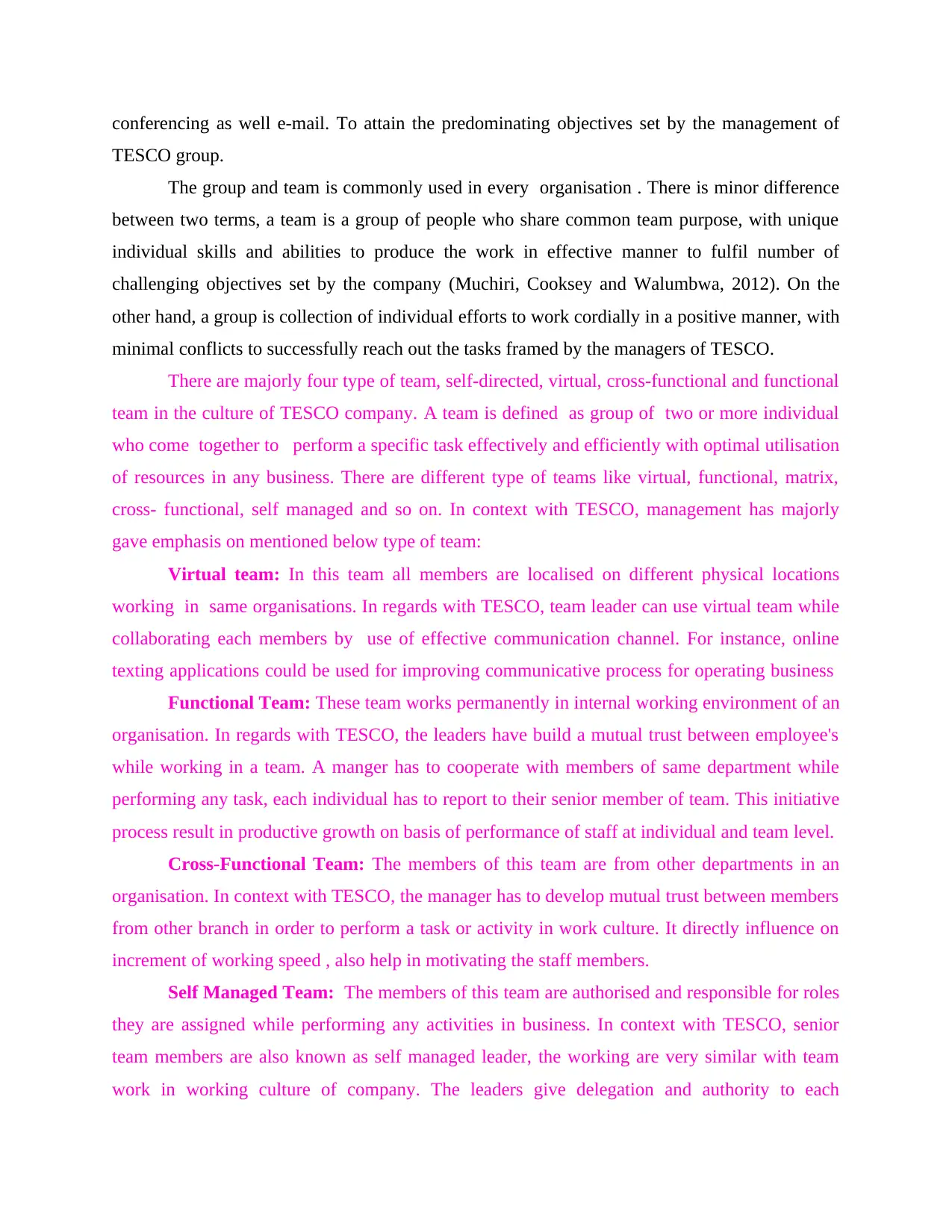
conferencing as well e-mail. To attain the predominating objectives set by the management of
TESCO group.
The group and team is commonly used in every organisation . There is minor difference
between two terms, a team is a group of people who share common team purpose, with unique
individual skills and abilities to produce the work in effective manner to fulfil number of
challenging objectives set by the company (Muchiri, Cooksey and Walumbwa, 2012). On the
other hand, a group is collection of individual efforts to work cordially in a positive manner, with
minimal conflicts to successfully reach out the tasks framed by the managers of TESCO.
There are majorly four type of team, self-directed, virtual, cross-functional and functional
team in the culture of TESCO company. A team is defined as group of two or more individual
who come together to perform a specific task effectively and efficiently with optimal utilisation
of resources in any business. There are different type of teams like virtual, functional, matrix,
cross- functional, self managed and so on. In context with TESCO, management has majorly
gave emphasis on mentioned below type of team:
Virtual team: In this team all members are localised on different physical locations
working in same organisations. In regards with TESCO, team leader can use virtual team while
collaborating each members by use of effective communication channel. For instance, online
texting applications could be used for improving communicative process for operating business
Functional Team: These team works permanently in internal working environment of an
organisation. In regards with TESCO, the leaders have build a mutual trust between employee's
while working in a team. A manger has to cooperate with members of same department while
performing any task, each individual has to report to their senior member of team. This initiative
process result in productive growth on basis of performance of staff at individual and team level.
Cross-Functional Team: The members of this team are from other departments in an
organisation. In context with TESCO, the manager has to develop mutual trust between members
from other branch in order to perform a task or activity in work culture. It directly influence on
increment of working speed , also help in motivating the staff members.
Self Managed Team: The members of this team are authorised and responsible for roles
they are assigned while performing any activities in business. In context with TESCO, senior
team members are also known as self managed leader, the working are very similar with team
work in working culture of company. The leaders give delegation and authority to each
TESCO group.
The group and team is commonly used in every organisation . There is minor difference
between two terms, a team is a group of people who share common team purpose, with unique
individual skills and abilities to produce the work in effective manner to fulfil number of
challenging objectives set by the company (Muchiri, Cooksey and Walumbwa, 2012). On the
other hand, a group is collection of individual efforts to work cordially in a positive manner, with
minimal conflicts to successfully reach out the tasks framed by the managers of TESCO.
There are majorly four type of team, self-directed, virtual, cross-functional and functional
team in the culture of TESCO company. A team is defined as group of two or more individual
who come together to perform a specific task effectively and efficiently with optimal utilisation
of resources in any business. There are different type of teams like virtual, functional, matrix,
cross- functional, self managed and so on. In context with TESCO, management has majorly
gave emphasis on mentioned below type of team:
Virtual team: In this team all members are localised on different physical locations
working in same organisations. In regards with TESCO, team leader can use virtual team while
collaborating each members by use of effective communication channel. For instance, online
texting applications could be used for improving communicative process for operating business
Functional Team: These team works permanently in internal working environment of an
organisation. In regards with TESCO, the leaders have build a mutual trust between employee's
while working in a team. A manger has to cooperate with members of same department while
performing any task, each individual has to report to their senior member of team. This initiative
process result in productive growth on basis of performance of staff at individual and team level.
Cross-Functional Team: The members of this team are from other departments in an
organisation. In context with TESCO, the manager has to develop mutual trust between members
from other branch in order to perform a task or activity in work culture. It directly influence on
increment of working speed , also help in motivating the staff members.
Self Managed Team: The members of this team are authorised and responsible for roles
they are assigned while performing any activities in business. In context with TESCO, senior
team members are also known as self managed leader, the working are very similar with team
work in working culture of company. The leaders give delegation and authority to each
⊘ This is a preview!⊘
Do you want full access?
Subscribe today to unlock all pages.

Trusted by 1+ million students worldwide

individual in self managed team. It majorly influence on growth of relationship between member
in a team.
Belbins theory for Tesco
1. Resource Investigator- They are innovative and curious. The members of Tesco
explores various options, develop contacts, and negotiate for resources on behalf of
whole team.
2. Team Worker- These are people who support and ensure that people in team are
working together in effective and efficient manner.
3. Co-Ordinator- These are people who act as traditional team leader and normally are
referred to as chairman. They guide team of Tesco to accomplish objectives on time.
4. Plant- They are creative and innovative who bring new ideas and approaches for long
term growth and success of Tesco.
5. Monitor Evaluator- These are best at evaluating and analysing ideas to achieve
objectives effectively.
6. Specialist- They have specialised knowledge that are required to perform by employees
of Tesco to get work done on time.
7. Shaper- They give challenges to employees of Tesco with the motive to improve as per
dynamic business environment.
8. Implementer- They are people who get things done and work systematically and are
inflexible.
9. Complete Finisher- They work with motive to see that projects are completed and
ensures that no errors are their in the project.
Difference between team and group
Team Group
A team is collaboration of members who are
integrated together for completing a specific
task assigned by management of any
organisations. The individual shares common
goals and particular duties and responsibilities
A group is combinations of individual who
give their efforts while performing any task or
activity. There is clear transparency of
informations, authority power, mutual trust
between each members where they can work
in a team.
Belbins theory for Tesco
1. Resource Investigator- They are innovative and curious. The members of Tesco
explores various options, develop contacts, and negotiate for resources on behalf of
whole team.
2. Team Worker- These are people who support and ensure that people in team are
working together in effective and efficient manner.
3. Co-Ordinator- These are people who act as traditional team leader and normally are
referred to as chairman. They guide team of Tesco to accomplish objectives on time.
4. Plant- They are creative and innovative who bring new ideas and approaches for long
term growth and success of Tesco.
5. Monitor Evaluator- These are best at evaluating and analysing ideas to achieve
objectives effectively.
6. Specialist- They have specialised knowledge that are required to perform by employees
of Tesco to get work done on time.
7. Shaper- They give challenges to employees of Tesco with the motive to improve as per
dynamic business environment.
8. Implementer- They are people who get things done and work systematically and are
inflexible.
9. Complete Finisher- They work with motive to see that projects are completed and
ensures that no errors are their in the project.
Difference between team and group
Team Group
A team is collaboration of members who are
integrated together for completing a specific
task assigned by management of any
organisations. The individual shares common
goals and particular duties and responsibilities
A group is combinations of individual who
give their efforts while performing any task or
activity. There is clear transparency of
informations, authority power, mutual trust
between each members where they can work
Paraphrase This Document
Need a fresh take? Get an instant paraphrase of this document with our AI Paraphraser
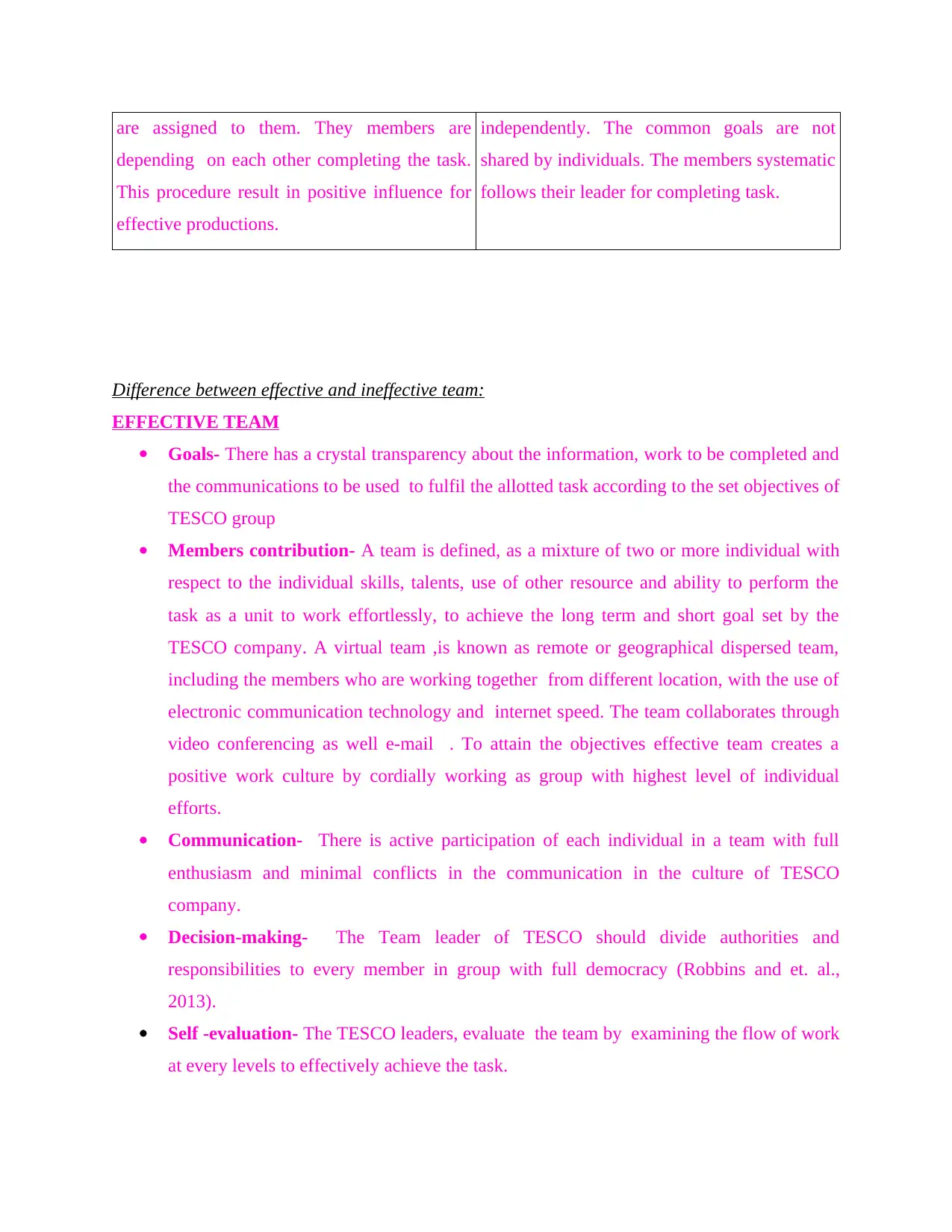
are assigned to them. They members are
depending on each other completing the task.
This procedure result in positive influence for
effective productions.
independently. The common goals are not
shared by individuals. The members systematic
follows their leader for completing task.
Difference between effective and ineffective team:
EFFECTIVE TEAM
Goals- There has a crystal transparency about the information, work to be completed and
the communications to be used to fulfil the allotted task according to the set objectives of
TESCO group
Members contribution- A team is defined, as a mixture of two or more individual with
respect to the individual skills, talents, use of other resource and ability to perform the
task as a unit to work effortlessly, to achieve the long term and short goal set by the
TESCO company. A virtual team ,is known as remote or geographical dispersed team,
including the members who are working together from different location, with the use of
electronic communication technology and internet speed. The team collaborates through
video conferencing as well e-mail . To attain the objectives effective team creates a
positive work culture by cordially working as group with highest level of individual
efforts.
Communication- There is active participation of each individual in a team with full
enthusiasm and minimal conflicts in the communication in the culture of TESCO
company.
Decision-making- The Team leader of TESCO should divide authorities and
responsibilities to every member in group with full democracy (Robbins and et. al.,
2013).
Self -evaluation- The TESCO leaders, evaluate the team by examining the flow of work
at every levels to effectively achieve the task.
depending on each other completing the task.
This procedure result in positive influence for
effective productions.
independently. The common goals are not
shared by individuals. The members systematic
follows their leader for completing task.
Difference between effective and ineffective team:
EFFECTIVE TEAM
Goals- There has a crystal transparency about the information, work to be completed and
the communications to be used to fulfil the allotted task according to the set objectives of
TESCO group
Members contribution- A team is defined, as a mixture of two or more individual with
respect to the individual skills, talents, use of other resource and ability to perform the
task as a unit to work effortlessly, to achieve the long term and short goal set by the
TESCO company. A virtual team ,is known as remote or geographical dispersed team,
including the members who are working together from different location, with the use of
electronic communication technology and internet speed. The team collaborates through
video conferencing as well e-mail . To attain the objectives effective team creates a
positive work culture by cordially working as group with highest level of individual
efforts.
Communication- There is active participation of each individual in a team with full
enthusiasm and minimal conflicts in the communication in the culture of TESCO
company.
Decision-making- The Team leader of TESCO should divide authorities and
responsibilities to every member in group with full democracy (Robbins and et. al.,
2013).
Self -evaluation- The TESCO leaders, evaluate the team by examining the flow of work
at every levels to effectively achieve the task.
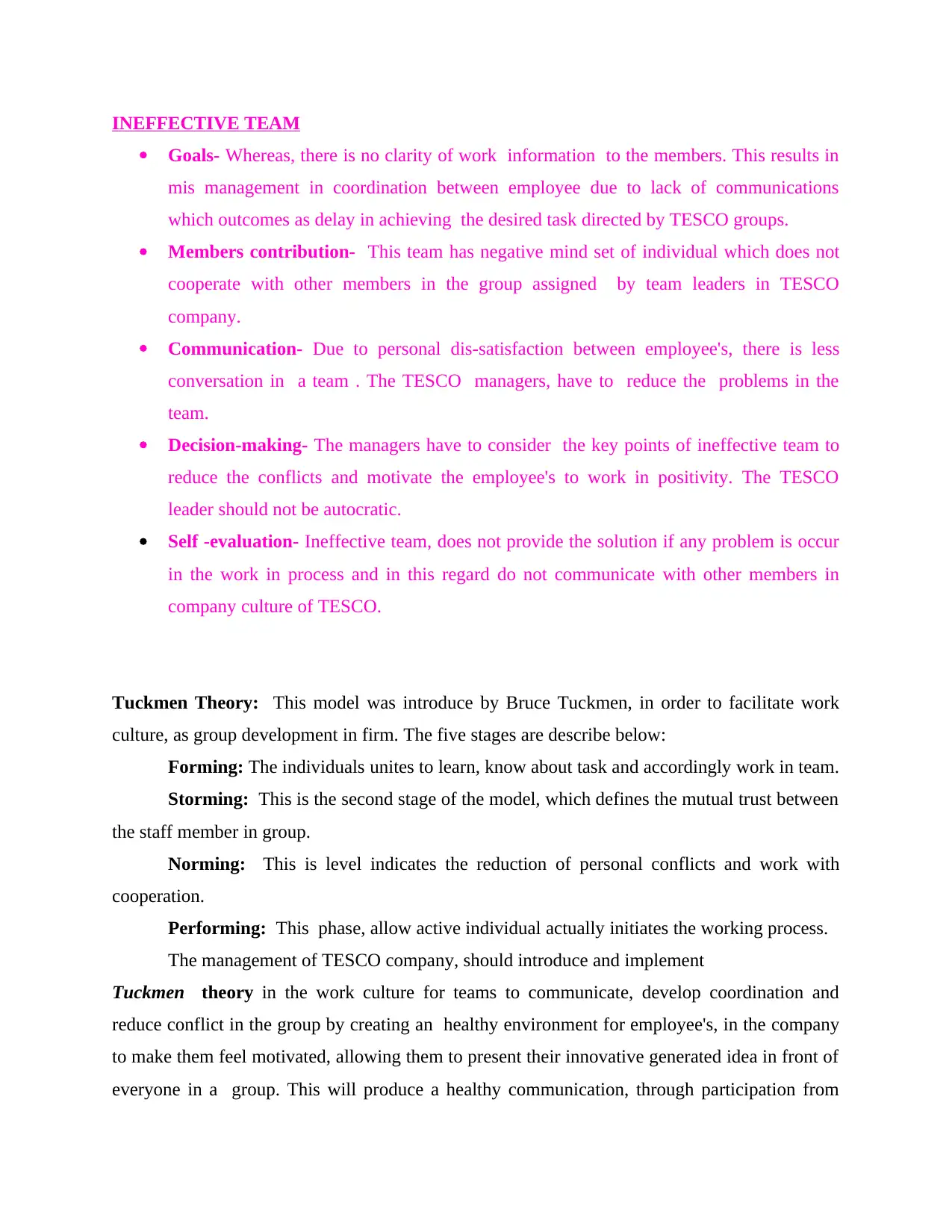
INEFFECTIVE TEAM
Goals- Whereas, there is no clarity of work information to the members. This results in
mis management in coordination between employee due to lack of communications
which outcomes as delay in achieving the desired task directed by TESCO groups.
Members contribution- This team has negative mind set of individual which does not
cooperate with other members in the group assigned by team leaders in TESCO
company.
Communication- Due to personal dis-satisfaction between employee's, there is less
conversation in a team . The TESCO managers, have to reduce the problems in the
team.
Decision-making- The managers have to consider the key points of ineffective team to
reduce the conflicts and motivate the employee's to work in positivity. The TESCO
leader should not be autocratic.
Self -evaluation- Ineffective team, does not provide the solution if any problem is occur
in the work in process and in this regard do not communicate with other members in
company culture of TESCO.
Tuckmen Theory: This model was introduce by Bruce Tuckmen, in order to facilitate work
culture, as group development in firm. The five stages are describe below:
Forming: The individuals unites to learn, know about task and accordingly work in team.
Storming: This is the second stage of the model, which defines the mutual trust between
the staff member in group.
Norming: This is level indicates the reduction of personal conflicts and work with
cooperation.
Performing: This phase, allow active individual actually initiates the working process.
The management of TESCO company, should introduce and implement
Tuckmen theory in the work culture for teams to communicate, develop coordination and
reduce conflict in the group by creating an healthy environment for employee's, in the company
to make them feel motivated, allowing them to present their innovative generated idea in front of
everyone in a group. This will produce a healthy communication, through participation from
Goals- Whereas, there is no clarity of work information to the members. This results in
mis management in coordination between employee due to lack of communications
which outcomes as delay in achieving the desired task directed by TESCO groups.
Members contribution- This team has negative mind set of individual which does not
cooperate with other members in the group assigned by team leaders in TESCO
company.
Communication- Due to personal dis-satisfaction between employee's, there is less
conversation in a team . The TESCO managers, have to reduce the problems in the
team.
Decision-making- The managers have to consider the key points of ineffective team to
reduce the conflicts and motivate the employee's to work in positivity. The TESCO
leader should not be autocratic.
Self -evaluation- Ineffective team, does not provide the solution if any problem is occur
in the work in process and in this regard do not communicate with other members in
company culture of TESCO.
Tuckmen Theory: This model was introduce by Bruce Tuckmen, in order to facilitate work
culture, as group development in firm. The five stages are describe below:
Forming: The individuals unites to learn, know about task and accordingly work in team.
Storming: This is the second stage of the model, which defines the mutual trust between
the staff member in group.
Norming: This is level indicates the reduction of personal conflicts and work with
cooperation.
Performing: This phase, allow active individual actually initiates the working process.
The management of TESCO company, should introduce and implement
Tuckmen theory in the work culture for teams to communicate, develop coordination and
reduce conflict in the group by creating an healthy environment for employee's, in the company
to make them feel motivated, allowing them to present their innovative generated idea in front of
everyone in a group. This will produce a healthy communication, through participation from
⊘ This is a preview!⊘
Do you want full access?
Subscribe today to unlock all pages.

Trusted by 1+ million students worldwide
1 out of 16
Related Documents
Your All-in-One AI-Powered Toolkit for Academic Success.
+13062052269
info@desklib.com
Available 24*7 on WhatsApp / Email
![[object Object]](/_next/static/media/star-bottom.7253800d.svg)
Unlock your academic potential
Copyright © 2020–2025 A2Z Services. All Rights Reserved. Developed and managed by ZUCOL.




